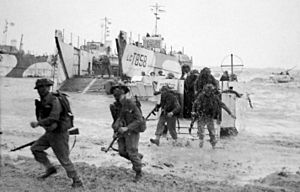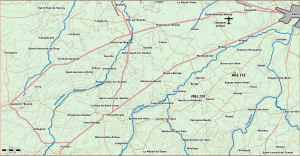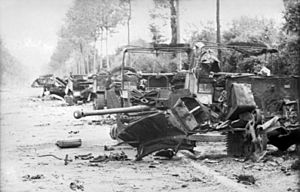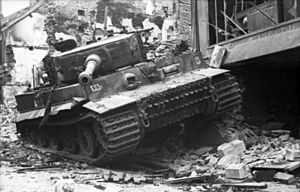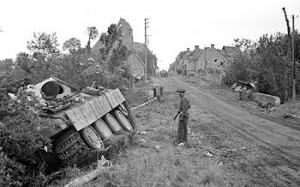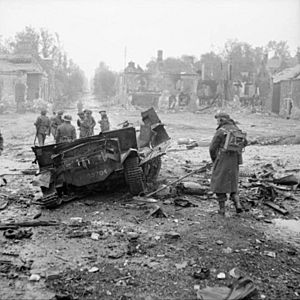Operation Perch facts for kids
Quick facts for kids Operation Perch |
|||||||
|---|---|---|---|---|---|---|---|
| Part of the Battle for Caen | |||||||
 Centaur IV tank of the Royal Marines Armoured Support Group near Tilly-sur-Seulles |
|||||||
|
|||||||
| Belligerents | |||||||
| Commanders and leaders | |||||||
| Strength | |||||||
| 1 armoured division 2 infantry divisions 2 armoured brigades |
3 panzer divisions 1 infantry division 1 heavy tank battalion |
||||||
Operation Perch was a British military plan during the Second World War. It took place from June 7 to 14, 1944. This was right after the D-Day invasion in Normandy, France. The main goal of Operation Perch was to surround and capture the city of Caen. Caen was an important target for the British forces on D-Day.
The original plan was for British troops to advance quickly southeast of Caen. But three days after D-Day, Caen was still held by German forces. So, the plan was changed. More British troops were added to try a "pincer attack" on Caen. This meant attacking from two sides to trap the German defenders.
British forces pushed south, facing strong German resistance. They fought hard battles, especially around the village of Tilly-sur-Seulles. German counter-attacks also slowed down the British advance from the east. With many soldiers getting hurt and no sign of the Germans giving up, the attack east of Caen was stopped on June 13.
Further west, American attacks created a gap in the German defenses. A British armored division was sent to go through this gap. They tried to go around the German forces to make them retreat. After two days of fighting, including the Battle of Villers-Bocage, the British troops were ordered to pull back. Plans to continue the attack were put on hold. A big storm in the English Channel made it hard to bring in more supplies and soldiers.
Historians still debate if the British commanders missed a chance to capture Caen. The Germans had to use their strongest tank units to stop this attack. This meant they had fewer tanks for their own counter-attacks. This gave the Allies an advantage.
Background of the Battle
Operation Overlord: The Big Plan
The town of Caen was a key target for the British on D-Day, June 6, 1944. British soldiers landed on Sword Beach and were supposed to capture it. Taking Caen was the most ambitious goal for the British I Corps. The overall plan for D-Day, called Operation Overlord, aimed for the British Second Army to secure Caen. Then, they would create a strong front line to protect the American forces moving towards Cherbourg.
Controlling Caen and the areas around it would give the British a good starting point. From there, they could push south to capture Falaise. This area was open and dry, perfect for fast tank movements. The Allies had many more tanks than the Germans. So, a battle where they could move quickly would be good for them.
Operation Perch: The First Attack
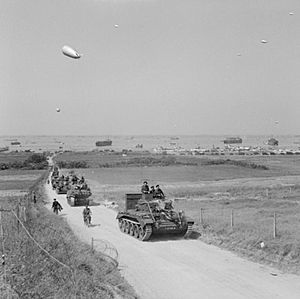
Operation Perch was designed to make the Germans think the British were about to break out. The plan was for the British 50th (Northumbrian) Infantry Division to land on Gold Beach. They would quickly move inland to capture Bayeux and the road to Tilly-sur-Seulles. After that, the 7th Armoured Division would take over. They would advance from Tilly-sur-Seulles towards Mont Pinçon.
On D-Day, June 6, the British XXX Corps landed on Gold Beach. They cleared paths off the beach and moved about 5 miles (8 km) inland. But German resistance at Le Hamel slowed them down. They couldn't reach all their D-Day goals before nightfall. Patrols did reach Bayeux and met Canadian troops from Juno Beach.
On June 7, most of the 7th Armoured Division landed as planned. XXX Corps then secured its remaining D-Day targets, including Bayeux. German forces tried to counter-attack the British. But these attacks failed, and many German units were destroyed. Meanwhile, the British 3rd Infantry Division, landing on Sword Beach, moved towards Caen. But they were stopped by the German 21st Panzer Division just outside the city.
Getting Ready for Battle
Operation Wild Oats: A New Plan
By June 9, the Allied commanders decided on a new plan to take Caen. It was called Operation Wild Oats. They would use a "pincer movement." From the east, the British 51st (Highland) Infantry Division would cross the Orne River. They would attack towards Cagny, southeast of Caen. From the west, the British 7th Armoured Division would cross the Odon River. They would try to capture Évrecy and Hill 112.
The original plan also included dropping airborne troops between these two attacks. However, the Allied air commander decided this was too risky for the transport planes. So, the airborne part of the plan was cancelled.
German Defenses
The Germans quickly moved their best tank divisions to Normandy. These included the Panzer-Lehr Division, the 12th SS-Panzer Division, and the 21st Panzer Division. These units were ordered to stop the Allied invasion.
On June 9, the Panzer-Lehr Division arrived near Tilly-sur-Seulles. They had lost many vehicles to air attacks on their way there. Parts of the 12th SS-Panzer Division and the 21st Panzer Division were moved to Caen. They faced the British I Corps. The Germans launched several attacks against the British and Canadian beachheads. But these attacks were pushed back. By the evening of June 9, British troops met the tanks of the Panzer-Lehr Division near Tilly-sur-Seulles.
The Battle Unfolds
Fighting in the West: XXX Corps
On June 10, the British 7th Armoured Division took over some of the front lines. By nightfall, they reached the edge of Tilly-sur-Seulles. The next day, they managed to get into the village and capture the main crossroads. But the German Panzer-Lehr Division launched several counter-attacks. These forced the British out of the village. The fighting was tough, especially in the bocage (a landscape of small fields and hedgerows).
German leaders wanted to replace their tank divisions with infantry. This would allow them to use the tanks elsewhere. But Adolf Hitler ordered them not to retreat. Instead, he wanted them to attack the Allied beachhead.
Fighting in the East: I Corps
The attack by the British I Corps was delayed until June 12. Bad weather slowed down the arrival of more troops. On June 10, German tanks and infantry attacked the British 6th Airborne Division. This stopped the British from attacking first. The Germans were pushed back with the help of naval gunfire. One German officer said his "battalion had been virtually wiped out" after 12 hours of fighting.
On June 11, the British 51st Highland Division arrived. They attacked a village called Bréville, but this was a costly failure. Other parts of the division secured Touffréville. On June 12, the Germans attacked again from the Bréville area. The fighting lasted all day, with heavy losses on both sides. To close a gap in the British lines, they captured Bréville at midnight. But this came at a high cost. The 51st Highland Division faced strong resistance from the 21st Panzer Division. With the British advance stopped, the attack east of Caen was called off on June 13.
The Caumont Gap
Even though the attack on Caen had been stopped, a new chance appeared. This was on the right side of the British XXX Corps, where the British and American armies met. The Allies had destroyed several German battle groups in this area. This left a 7.5-mile (12 km) gap in the German lines near Caumont-l'Éventé. Only a small German reconnaissance unit was left there.
The Germans planned to use the 2nd Panzer Division to close this gap. But most of this division was still far away. So, German commanders rushed a small reconnaissance unit to Caumont. They also ordered a heavy tank battalion, Schwere SS-Panzerabteilung 101, to move to cover the open flank. This included five powerful Tiger tanks led by Michael Wittmann. They arrived on June 12.
On June 12, British commanders decided to use this gap. The 7th Armoured Division was ordered to leave the fighting around Tilly-sur-Seulles. They would move through the gap to capture Villers-Bocage. Then, they would advance behind the German Panzer-Lehr Division. This would force the Panzer-Lehr Division to retreat or be trapped. American forces would also push forward to support this move.
The 7th Armoured Division was slow to move at first. But by 4:00 PM, they began their advance. They moved 12 miles (19 km) unopposed, even through German-held territory. They stopped for the night near La Mulotiere to keep their objective a secret.
Battle of Villers-Bocage
The British advance started again at 5:30 AM on June 13. By 8:30 AM, the lead British tanks entered Villers-Bocage. A squadron of tanks moved through the town and took a high ground area called Point 213.
Around 9:00 AM, Michael Wittmann's Tiger tank attacked the British. He drove into Villers-Bocage and destroyed several British tanks and vehicles. He then attacked other British tanks entering the town. In less than 15 minutes, Wittmann destroyed 13-14 tanks, two anti-tank guns, and 13-15 transport vehicles. His Tiger tank was later stopped by British fire and abandoned.
For the rest of the morning, British infantry took up defensive positions in the town. The troops at Point 213 were cut off. A relief force tried to reach them but failed. More German forces arrived, and the trapped squadron surrendered.
Tanks from the Panzer-Lehr Division tried to block the exits from Villers-Bocage. But they were ambushed by British anti-tank guns. Several German tanks were disabled. More German tanks were knocked out in the town center by British anti-tank guns and infantry. British and German infantry fought throughout the afternoon. The British positions were heavily shelled. After a long day of fighting, the British decided to pull back to a safer position. The withdrawal began at 8:00 PM under artillery cover.
June 14: Continued Fighting
50th (Northumbrian) Infantry Division Attacks
On the morning of June 14, the British commander, General Montgomery, decided to stop the pincer attack on Caen. He felt they didn't have enough strength for it. The 50th (Northumbrian) Infantry Division continued its attack south. This was to keep German forces busy.
The main attack began at 10:15 AM. British infantry and tanks advanced towards Lingèvres and Verrières. The German defenders waited until the British were very close before opening fire. The fighting was intense. The British 6th Durham Light Infantry (DLI) captured the German positions with strong artillery support. They reached Verrières, which was empty. But further advances were stopped by German infantry and tanks.
Later, the 9th DLI captured Lingèvres. They brought anti-tank guns into the village. Sergeant Wilfred Harris, commanding a Sherman Firefly tank, spotted two German Panther tanks. He destroyed one and disabled the other. Other British soldiers finished off the damaged Panther. Harris later destroyed three more Panther tanks. The British 231st Infantry Brigade reached its goals by nightfall. Nine German tanks were destroyed that day. But the 50th (Northumbrian) Infantry Division could not break through the strong German defenses. The DLI suffered about 353 casualties.
Battle of the Island
The British 22nd Armoured Brigade group finished their withdrawal by June 14. They formed a defensive "box" near Hill 174. This battle became known as the Battle of the Island or the Battle of the Brigade Box.
The German Panzer-Lehr Division defended against the British attacks. They also counter-attacked the British "box" with Tiger tanks. Other small German units also faced the British. During the morning, German infantry attacked the box. They came too close for artillery fire, and hand-to-hand fighting began. A British platoon was overrun, but a counter-attack restored the position. The Germans then used constant shelling and sniping. At 7:00 PM, tanks and infantry attacked from two sides. They broke into the box but were pushed back by 10:30 PM.
Operation Aniseed
The British commander felt the "box" was secure. But since the 50th Northumbrian Division couldn't break through, the brigade group was ordered to retreat. This withdrawal was called Operation Aniseed. It began just after midnight. British bombers attacked German positions to distract them. The Germans did little to stop the British retreat. German losses included 700-800 soldiers and 8-20 tanks. British casualties were light, with only three tanks lost.
After the Battle
Soldier Losses
During Operation Perch, the German Schwere SS-Panzerabteilung 101 lost 27 soldiers. They had nine tanks destroyed and 21 damaged. By June 16, they had only 15 working tanks.
For most of the other units, exact casualty numbers are not available for Operation Perch alone. By the end of June, the German Panzer-Lehr Division had lost 2,972 soldiers. They also reported losing 51 tanks and many other vehicles. The 12th SS-Panzer Division had lost 1,417 soldiers by June 16. The 21st Panzer Division had lost 1,864 soldiers by June 16.
By the end of June, the British 7th Armoured Division had lost 1,149 soldiers and at least 38 tanks during Operation Perch. The 50th (Northumbrian) Infantry Division had suffered 4,476 casualties by the end of the month.
Recognizing the Fights
The British military system recognized the bravery shown during Operation Perch. They awarded "battle honours" to units that fought in these areas. For example, units received honors for fighting at Port En Bessin, Sully, Breville, and Villers-Bocage. Ten units also received the honor Tilly Sur Seulles for fighting there between June 14 and 19.
What Happened Next
The battle between the British 50th Northumbrian Division and the German Panzer-Lehr Division continued for several days. On June 18, the British re-entered Tilly-sur-Seulles. They secured the village the next day. The village had changed hands 23 times during the fighting.
The British 7th Armoured Division was pulled back to get more soldiers and tanks. They planned to attack again. But on June 19, a big storm hit the English Channel. This delayed the arrival of supplies and reinforcements. So, British attacks were postponed. Caen, north of the Orne River, was finally captured during Operation Charnwood in early July. The northern parts of the city were taken during Operation Atlantic later that month.


